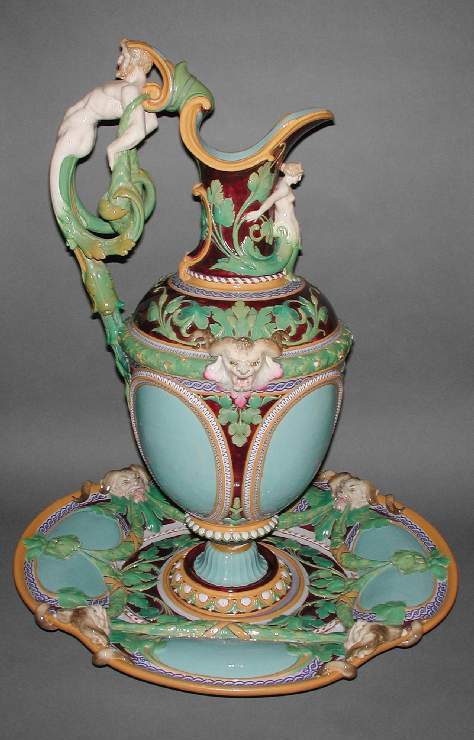Current Location: In storage
Titles
Ewer and stand
Maker(s)
Factory:
Minton & Co.
Designer:
Jeannest, Pierre Emile
Entities
Categories
Description
Earthenware ewer and stand, moulded in several parts and decorated with applied high relief figures, green, ochre, buff and magenta majolica glazes and blue enamel.
The ewer is of classical shape with a small foot, ovoid body, tall neck and scrolled rim. The highly ornate loop handle which extends above the rim is modelled as Triton, a merman bending backwards and clutching his bifurcated foliate tail. A moulded mermaid is applied below the spout, her arms spread as on the prow of a ship. The body is decorated with applied green foliage set on a magenta ground, two moulded masks and four large oval turquoise panels. The underside is hollow and clear-glazed, except for a broad foot-rim, with a central metal wing-nut bolting the base to the body.
The stand is oval with a wide flared rim. Around the rim are four more moulded masks, holding oak-leaf swags over four slightly convex, plain turquoise ovals. The circular centre is mid-blue, encircled by a thin band of ochre and a wider band of green foliage on magenta ground. The underside is clear glazed.
Notes
History note: Charles and Lavinia Handley-Read Collection, London;
Legal notes
Purchased with the Perceval Fund and grant-in-aid from the Victoria and Albert Museum
Acquisition and important dates
Method of acquisition: Bought
(1972-10-19)
by
Stainton, Thomas
Dating
Victorian
Production date:
AD 1856
: date mark for 1856
Note
At least five examples of this shape, designed by Pierre Emile Jeannest (1813-57), are known. This and another have plain turquoise panels. Others have finely painted narrative panels. One of these, now in the Victoria & Albert Museum (no.8107&A-1863), was painted by Thomas Allen with classical gods (after Polidoro da Caravaggio) while the stand shows the Labours of Hercules (after Lebrun). It was shown by Minton at the London International Exhibition of 1862. The shape, however, was in use earlier as indicated by the date-mark, 1856, on the Fitzwilliam example and an early listing in the Minton ornamental shape book 3, c.1854-62, which reads: ‘616: ‘Ewer and stand, Jeannest, with Triton handle, H.2’6” ‘. The Greek god Triton, son of Poseidon, was the messenger of the sea; he is typically represented as the merman seen here.
Minton, founded in 1793, originally produced blue printed earthenware and, later, creamware, bone china and other products, particularly tableware. Taking over in 1836, Herbert Minton (1793-1858) revolutionised production methods and introduced new lines in encaustic and printed tiles, figures and ornamental wares. In 1858 the business passed to Herbert’s nephew, Colin Minton Campbell (1827-85), who continued the expansion. The early business traded under various names, from 1845 it was known as Minton & Co. and from 1873 as Mintons Ltd.
Pierre-Emile Jeannest, (1813 – 1857) was a French ceramic and silver designer. The son of a sculptor, he worked for Minton c.1846-1852, designing Parian figures, majolica ware and tableware. He later worked for Elkingtons, designing silver, whilst continuing to supply Minton designs as a freelance. He also taught the model class at Stoke School of Design.
This is a particularly ambitious example of mid-nineteenth century ceramics combining Renaissance sources with innovation. Minton launched wares ‘coloured in the Majolica style’ at the Great Exhibition of 1851, to great acclaim. The new product took inspiration from Italian maiolica, tin-glazed earthenware with finely painted decoration, Della Robbia sculpture, and the brightly coloured lead-glazes favoured by Bernard Palissy. Other factories, including Wedgwood, followed suit, but Minton’s Majolicaware developed in the late 1840s was notable for an exceptionally wide palette of glazes developed under the leadership of Art Director Léon Arnoux.
School or Style
Renaissance Revival
People, subjects and objects depicted
Components of the work
Decoration
composed of
lead-glaze
enamel
Stand
Depth 56 cm
Height 8 cm
Width 62.5 cm
Ewer
Height 75 cm
Width 33 cm
Materials used in production
Earthenware
Techniques used in production
Modelling
: Earthenware, moulded and modelled, decorated with Majolica glazes and blue enamel
Moulding
Inscription or legends present
Inscription present: circle with protruding line
- Location: Underside of stand
- Method of creation: Impressed
- Type: Mark
Inscription present: A or triangle
- Text: A
- Location: Underside of stand
- Method of creation: Impressed
- Type: Mark
Inscription present: smudge
- Location: Underside of ewer
- Method of creation: Painted in blue
- Type: Mark?
References and bibliographic entries
-
Victorian and Edwardian Decorative Art , The Handley-Read Collection
page(s): 49
-
Fitzwilliam Museum Handbooks, English Pottery
page(s): 110-11
-
Minton 1798-1910
page(s): 95-7
-
19th Century Furniture, Sculpture, Ceramics, Silver and Works of Art
-
High Victorian Decorative Arts and Design
-
British Ceramics and Glass, including Welsh Porcelain
page(s): 78
-
Connoisseur
page(s): August 1976, p.290
-
Masterpieces of World Ceramics
page(s): 116-117
-
Dictionary of Minton
page(s): 54,78,123
-
Minton: The First Two Hundred Years of Design & Production
page(s): 123,140.
-
Minton ‘Majolica’: an historical survey and exhibition catalogue
page(s): 24
-
Majolica: British, Continental and American Wares, 1851-1915
page(s): 27-44
-
The Ceramic Art of Great Britain
page(s): 204
Related exhibitions
Identification numbers
Accession number: C.40 & A-1972
Primary reference Number: 74920
Stable URI
Audit data
Created: Saturday 6 August 2011
Updated: Tuesday 30 April 2024
Last processed: Monday 4 August 2025
Associated departments & institutions
Owner or interested party:
The Fitzwilliam Museum
Associated department:
Applied Arts








